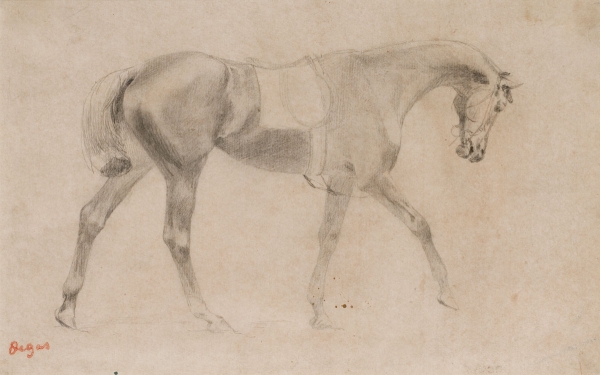DEGAS, Saddle Horse

Edgar DEGAS (1834-1917)
Saddle Horse
ca. 1862
graphite on tracing paper
17.8 x 28.1 cm
© MuMa Le Havre / Florian Kleinefenn
Saddle Horse
ca. 1862
graphite on tracing paper
17.8 x 28.1 cm
© MuMa Le Havre / Florian Kleinefenn
HD image
During the public sale of Degas' studio collection, Olivier Senn purchased three sets of drawings representing a total of twelve numbers on the theme of horse racing.
With a confident line, Degas draws the contours of the animal's body seen in profile. Using very fine cross-hatching, he shades the rounded forms of the horse to emphasize the intricacy of its muscles and joints, as well as the sheen of its short coat.
The silhouette of this race horse at a walk, its head down, is found in the first race scenes painted by Degas around 1862 featuring a frieze composition. It can be seen in At the Races, The Start at the Fogg Art Museum, in which the central horse in the foreground is depicted in a similar posture, the head only slightly more pulled down toward its chest, as well as in The Gentlemen's Race, Before the Start at the Musée d’Orsay, where the animal's head is largely hidden behind the croup of another horse in front of it. Mention can also be made of the 1862 drawing that Senn wished to acquire and is now held at the Sterling and Francine Clark Art Institute in Williamstown, Massachusetts, At the Races, even though the horse has a different gait.
There are other drawings very similar to the Saddle Horse at MuMa. Degas seems to have produced several versions of the same drawing, as much to further his exploration as for the purpose of selling them.
With a confident line, Degas draws the contours of the animal's body seen in profile. Using very fine cross-hatching, he shades the rounded forms of the horse to emphasize the intricacy of its muscles and joints, as well as the sheen of its short coat.
The silhouette of this race horse at a walk, its head down, is found in the first race scenes painted by Degas around 1862 featuring a frieze composition. It can be seen in At the Races, The Start at the Fogg Art Museum, in which the central horse in the foreground is depicted in a similar posture, the head only slightly more pulled down toward its chest, as well as in The Gentlemen's Race, Before the Start at the Musée d’Orsay, where the animal's head is largely hidden behind the croup of another horse in front of it. Mention can also be made of the 1862 drawing that Senn wished to acquire and is now held at the Sterling and Francine Clark Art Institute in Williamstown, Massachusetts, At the Races, even though the horse has a different gait.
There are other drawings very similar to the Saddle Horse at MuMa. Degas seems to have produced several versions of the same drawing, as much to further his exploration as for the purpose of selling them.

















